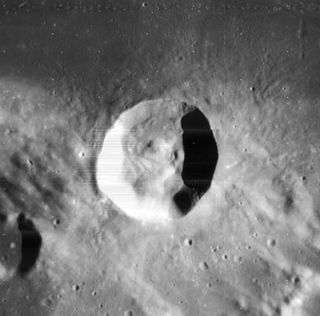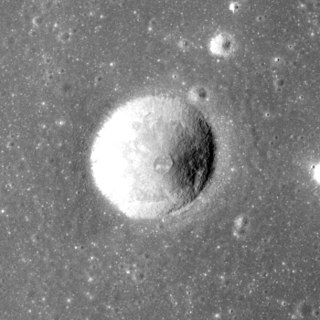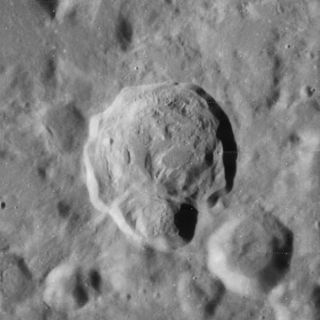
Plinius is a prominent lunar impact crater on the border between Mare Serenitatis to the north and Mare Tranquilitatis to the south. Its diameter is 41 km. The crater is named after the Roman natural scientist and author Pliny the Elder. To the south-southeast of Plinius is the crater Ross, and to the northeast is Dawes. Just to the north is a system of rilles named the Rimae Plinius and touching it is the Brackett crater which is more than a crater diameter north. At the northwest edge of the rille is the Promontorium Archerusia, a cape off the western rim that encloses the Mare Serenitatis.

Chacornac is an irregular lunar impact crater attached to the southeast rim of the crater Posidonius. It lies just to the east of the Mare Serenitatis, and north of the crater Le Monnier. The crater is named after French astronomer Jean Chacornac.

Menelaus is a young lunar impact crater located on the southern shore of Mare Serenitatis near the eastern end of the Montes Hæmus mountain range. Its diameter is 27 km. To the southwest is the small crater Auwers, and to the west-southwest is the even smaller Daubrée. To the northeast is a faint rille system named the Rimae Menelaus.

Posidonius is a lunar impact crater that is located on the north-eastern edge of Mare Serenitatis, to the south of Lacus Somniorum. It was named after ancient Greek philosopher and geographer Posidonius of Apamea. The crater Chacornac is attached to the southeast rim, and to the north is Daniell.

Borel is a tiny lunar impact crater located in the southeast part of Mare Serenitatis. It was named after French mathematician Émile Borel. To the northeast is the crater Le Monnier and to the southeast is the crater Abetti. Borel was previously identified as Le Monnier C.

Finsch is a relatively small lunar impact crater in the mid-part of Mare Serenitatis that has been almost completely covered by the mare, forming a ghost crater in the lava plain. It was named after German zoologist Otto Finsch. It is located to the south-southeast of the crater Sarabhai and northeast of Bessel.

Al-Bakri is a small lunar impact crater on the northwest edge of Mare Tranquillitatis. It is named after the Spanish Arab geographer and historian Abu Abdullah al-Bakri. It is just south of the eastern arm of the Montes Haemus that borders the Mare Serenitatis to the north. To the east-northeast is the prominent crater Plinius. South of the crater are the rilles of the Rimae Maclear.

Aratus is a small lunar impact crater located on the highland to the south and east of the rugged Montes Apenninus range. It is a circular, cup-shaped crater with a relatively high albedo. It was named after Greek astronomer Aratus of Soli. To the east is the Mare Serenitatis, and to the southwest is the somewhat larger crater Conon. North-northeast of Aratus is the landing site of the Apollo 15 mission, just beyond Mons Hadley Delta.

Alexander is a lunar impact crater-like feature in the rugged surface to the north of Mare Serenitatis. It lies to the south-southwest of the prominent crater Eudoxus, and to the east-northeast of Calippus. It was named after Alexander the Great.

Archytas is a lunar impact crater that protrudes into the northern edge of Mare Frigoris. To the northwest is the comparably sized crater Timaeus, and the smaller Protagoras lies in the opposite direction to the southeast. Further to the southwest, beyond the opposite edge of the mare, is the dark-floored crater Plato.

Auwers is a small lunar impact crater located in the Montes Haemus mountain range at the south edge of Mare Serenitatis. It is named after German astronomer Arthur Auwers. It lies southeast of the crater Menelaus. The irregular rim of Auwers has a gap at the north-northwest edge, which allowed lava flows to reach the crater floor and flood the interior.

Babcock is a lunar impact crater that is located on the far side of the Moon. It was named after American astronomer Harold D. Babcock. It lies on the northeastern edge of Mare Smythii, to the southeast of Mare Marginis. To the south of Babcock is the crater Purkynĕ, and to the east-northeast lies Erro. Babcock is located in a region of the Moon's surface that is occasionally brought into view during favorable librations, although it is seen from the edge and so little detail can be discerned from an observer on the Earth.

Barnard is a lunar impact crater that is located near the eastern limb of the Moon. It is attached to the southeast rim of the large crater Humboldt, and Abel lies directly to the south. To the northeast is the crater Curie, while to the southeast is the Mare Australe.

Boyle is a lunar impact crater that is located in the southern hemisphere on the rugged far side of the Moon. It is adjacent to the larger crater Hess to the southeast, and lies about midway between the craters Alder to the north-northeast and Abbe to the south-southwest.

Fontenelle is a lunar impact crater that is located along the northern edge of Mare Frigoris, in the northern part of the Moon. To the northeast is the remnant of the crater Birmingham. Due to its location, this crater appears oval in shape when observed from the Earth because of foreshortening.

Vitello is a lunar impact crater that lies along the southern edge of the small Mare Humorum, in the southwest part of the Moon's near side. It was named after 13th century Polish theologian and physicist Vitello. It lies just to the east of the lava-flooded crater Lee. To the northeast along the edge of the lunar mare is the Rupes Kelvin, an irregular fault line.

Pettit is a lunar impact crater that lies near the western limb of the Moon. It was named after American astronomer Edison Pettit. In this location the crater is viewed nearly from the side by observers on Earth, and visibility can be significantly affected by libration effects.

Fabbroni is a small lunar impact crater that lies along the northern edge of the Mare Tranquillitatis, at the eastern edge of the gap where the lunar mare joins Mare Serenitatis to the north. To the southeast is the crater Vitruvius.

Catalán is a small lunar impact crater that lies almost along the southwest limb of the Moon. At this position the crater is ill-suited for observation from the Earth as it is viewed almost from the side, and visibility is subject to libration effects. It lies to the west of the somewhat larger crater Baade, and south-southeast of Graff. This region is located in the outer southeastern part of the skirt of ejecta that surrounds the Mare Orientale impact basin, and the nearby surface is rugged and streaky. This crater is named after the Spanish scientist Miguel Antonio Catalán Sañudo (1894–1957) for his contributions to spectroscopy, an important exploratory tool in astronomy.

Newcomb is a lunar impact crater that is located in the rugged Montes Taurus mountain range, to the east of the Mare Serenitatis. It lies to the northeast of the prominent crater Römer, and north-northwest of Macrobius.

























